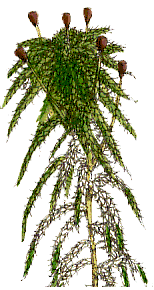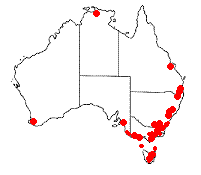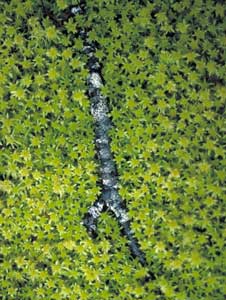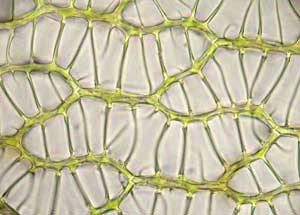
Ecology
Sphagnum
Sphagnum is one of the most important plant genera in the world. The use of the word "plant" rather than "bryophyte" in the preceding sentence is deliberate and correct. Sphagnum covers more of the world's land surface than any other single plant genus. Sphagnum is one of the few bryophyte genera able to dominate an ecosystem and it does so by creating conditions that deter other plants.
There are probably between 100 and 300 species of Sphagnum in the world. There is some plasticity in the form of the gametophyte, depending on the environmental conditions in which it is growing. This means that many of the species that have been described will undoubtedly turn out simply to be variants of other species. There is still much work to be done on Sphagnum taxonomy and the Sphagnum species in some parts of the world have been very little studied. A recently published taxonomic study concluded that there are six species of Sphagnum in Australia as well as the closely related Ambuchanania leucobryoides. That species, the only one in the genus, is endemic to Tasmania and was once included in the genus Sphagnum![]() .
.
Sphagnum is associated with wet habitats and there are various terms for waterlogged environments: bog, fen, mire, swamp, to give a few examples. In ecological work these terms have precise definitions but some are also used more loosely in everyday speech. For the purpose of this web page, the exact nature of the wet habitats is not relevant so I'll use the neutral, all-encompassing expression "Sphagnum wetland". This photo ![]() shows a Sphagnum wetland in Mount Field National Park, Tasmania. The photo also shows the range of colours to be seen in different Sphagnum species, from green to reddish-brown
shows a Sphagnum wetland in Mount Field National Park, Tasmania. The photo also shows the range of colours to be seen in different Sphagnum species, from green to reddish-brown
There are many printed references and internet sites which give information about Sphagnum. The following references supplied the bulk of the information on this web page. They give much of the basic information needed for an introduction to Sphagnum, are fairly recent and have good bibliographies![]() .
.
Habitats and growth habit
 Sphagnum grows in very wet areas, either in pools of water or where there is seepage and is able to grow well in stagnant, nutrient poor areas. Sphagnum is especially common in northern Eurasia and northern North America where glacial action has led to the creation of numerous bodies of water. However Sphagnum is by no means confined to those areas for the genus is also known from many areas in southern Asia, Africa, South America and Australasia. In Australia there are numerous Sphagnum wetlands in the alpine and sub-alpine areas of Tasmania and south-eastern mainland Australia but the genus is found in many other areas of Australia as well. The following map shows the distribution of the genus in Australia and has been compiled from information given by the publication listed in the first reference button on this page. In Australia the genus is found from alpine altitudes to almost sea level (for example, in the Jervis Bay Territory on the New South Wales south coast).
Sphagnum grows in very wet areas, either in pools of water or where there is seepage and is able to grow well in stagnant, nutrient poor areas. Sphagnum is especially common in northern Eurasia and northern North America where glacial action has led to the creation of numerous bodies of water. However Sphagnum is by no means confined to those areas for the genus is also known from many areas in southern Asia, Africa, South America and Australasia. In Australia there are numerous Sphagnum wetlands in the alpine and sub-alpine areas of Tasmania and south-eastern mainland Australia but the genus is found in many other areas of Australia as well. The following map shows the distribution of the genus in Australia and has been compiled from information given by the publication listed in the first reference button on this page. In Australia the genus is found from alpine altitudes to almost sea level (for example, in the Jervis Bay Territory on the New South Wales south coast).
Sphagnum plants typically grow in carpet-like communities, at times with several species growing together. Such a carpet is composed of numerous vertically oriented leafy stems with a density of 1-7 stems per square centimetre, depending on species. At the top of each stem there is a cluster of crowded branches, called the capitulum, with more sparsely spaced side-branches on the lower stem. as shown by the painting at the top of this page.
This photo ![]() shows a close side view of a Sphagnum plant and here
shows a close side view of a Sphagnum plant and here ![]() is a close view of the tops of several Sphagnum plants.
is a close view of the tops of several Sphagnum plants.
 dead twig lying on spagnum bog surface |
The stems are constantly growing upward at their apices and as stems grow upwards more and more of the lower stems become buried. Light penetrates only a short distance into a Sphagnum carpet so photosynthesis is restricted largely to the capitula. Some of the lower part of a Sphagnum plant is still alive and able to create a new shoot, for example if the main stem's growing apex is damaged. However, much of lower stem is dead though still connected to the capitulum. When you look down at the surface of a Sphagnum carpet it is the capitula that you see. Given that a Sphagnum plant is constantly growing at the apex, as the lower parts are dying, the capitula have been described as "eternally young". Such growth makes a Sphagnum plant potentially immortal and there is evidence of Sphagnum plants that have been growing for a thousand or more years.
As well as individual plants growing, a Sphagnum colony can expand by the addition of plants, by means of sexual or vegetative reproduction. A study into the growth of Sphagnum colonies on the island of Gotland in the Baltic Sea found annual, radial growth rates of between half a centimetre and 13 centimetres, with a mean value of 3.6 centimetres. The study involved eleven Sphagnum species but the great variation in annual growth rates was not entirely species dependent. The two species described as having the most robust growth forms tended to show the largest annual growth rates. However, even for each of these species there were significant differences in growth rates between different colonies. Those differences would have reflected the influences of different micro-habitats on the island![]() .
.
Sphagnum is found over a wide geographic and altitudinal range so it's not surprising that different species have different requirements. Some species can tolerate lower nutrient levels than other species, others less light than others, some can tolerate higher pH levels than others, and so on. The SPHAGNUM AND THE WATER TABLE CASE STUDY looks at the influence of the depth of the water table on several species.
Acidity
Sphagnum tends to acidify its surroundings. Alkalinity and acidity are measured by the pH scale. A pH of 0 indicates extreme acidity, a pH of 14 indicates extreme alkalinity and a pH of 7 indicates a neutral solution. Pure water has a pH of 7. The water in Sphagnum wetlands can reach a pH as low as 3 – about the same as the pH of orange or grapefruit juice.
An ion is an electrically charged atom or group of atoms. Ions are important to all life since it is in ionic form that many nutrients are passed into cells and waste products are passed out of cells. Acidity is determined by the concentration of hydrogen ions. An acid is a substance that generates hydrogen ions when dissolved in water and the greater the resulting hydrogen ion concentration the more acidic the substance is and consequently, but seemingly paradoxically, the lower the pH. Sphagnum cells selectively absorb mineral ions from and release hydrogen ions into the surrounding water. A growing Sphagnum plant is continuously creating sites at which this exchange of ions can take place and the major active substances at those ion exchange sites are uronic acids, which constitute 10-30% of the dry mass in Sphagnum. The uronic acids are held in the cell walls as a polymer, commonly referred to as sphagnan. Sphagnum plants also contain a variety of phenolic compounds. There is evidence that uronic acids are responsible for ion exchange at low pH levels, with the phenolic compounds working at higher pH levels. In Sphagnum plants the concentrations of the phenolic compounds are lower than those of the uronic acids.
Sphagnum, water and peat
Living Sphagnum plants have an impressive water holding potential, with a number of species able to hold 20 or more times their own weight in water. Sphagnum owes its great water-holding capacity to a combination of leaf structure and growth habit. The major part of a Sphagnum leaf is composed of empty, dead cells, with the chlorophyllous cells occupying just a small volume. This photo ![]() shows the surface view of part of a Sphagnum leaf. In the closer view (right) you can see both a few empty cells as well as a number of green, chlorophyllous cells. The empty cells readily take up water but a lot of water is also held between the overlapping leaves. There is some variation in the placement of the chlorophyllous cells, depending on species, and the following diagrams are stylized depictions of two of the arrangements. The diagrams show cross-sections, with the large grey cells being the empty cells and the red areas marking the locations of the chlorophyllous cells. The insides of the empty cells are connected to the outside world by tiny pores.
shows the surface view of part of a Sphagnum leaf. In the closer view (right) you can see both a few empty cells as well as a number of green, chlorophyllous cells. The empty cells readily take up water but a lot of water is also held between the overlapping leaves. There is some variation in the placement of the chlorophyllous cells, depending on species, and the following diagrams are stylized depictions of two of the arrangements. The diagrams show cross-sections, with the large grey cells being the empty cells and the red areas marking the locations of the chlorophyllous cells. The insides of the empty cells are connected to the outside world by tiny pores.

Given the ability to absorb large amounts of water Sphagnum plays a significant role in water regulation. Sphagnum absorbs a vast quantity of water during any heavy downpour or after snowmelt and then releases much of that water in a more gradual flow over a much longer period. Without the ameliorating effect of Sphagnum heavy rainfall could have a very erosive effect. There is evidence of that having happened at various places where Sphagnum cover has been lost. One example is the Peak District of England where much of the Sphagnum cover in the main watershed was destroyed by atmospheric pollution in the 19th and 20th centuries![]() .
.
The combination of stagnant water and a continuously high water table promotes the creation of low oxygen levels and this inhibits many decomposer organisms. In addition the uronic acids in live or dead Sphagnum cells bind ammonia, a potential source of nitrogen for wetland organisms. By limiting access to nitrogen Sphagnum further hinders decomposer organisms. There is also evidence that Sphagnum immobilizes bacteria by strongly binding them to Sphagnum cells. All in all there may be various ways in which decomposition is hindered and consequently organic matter can accumulate in a Sphagnum wetland and in this way an increasingly thick peat deposit is created.
Peat may be a mixture of dead plant materials but in many cases the peat is almost totally composed of dead Sphagnum and the species of Sphagnum are often collectively called the peat mosses. Over time a Sphagnum bordered lake may become filled with peat as the Sphagnum and peat encroach on the lake. In turn the peat-filled lake can be colonized by vascular plants. The extensive peatlands of the northern Northern Hemisphere have developed since the last ice age. The author of the book given in the next reference button notes the variation in the rate of growth of peat deposits:
The growth rate of many Sphagnum species exceeds the rate of decay, thus peat accumulates. Peat deposits in the glaciated portions of North America that have been free of ice for ten thousand years vary in depth from a few feet to 50 feet deep. Obviously some habitats are more conducive to peat formation than others
.
Over millennia sphagnan is steadily released from dead Sphagnum into the surrounding water and breaks down. The breakdown products react with proteins in buried organisms, for example tanning human skin and making it leathery, and inhibit decay. Organisms (and artefacts made from products such as wool, skin or leather) that are sunk in Sphagnum wetlands are thereby preserved and peatlands have yielded a number of well-preserved bodies. One of the best known is the Tollund Man from Denmark .
Peatlands can hold immense amounts of water. Hence, where a peatland is extensive it has a significant effect on the climate and hydrology of the surrounding area.
Sphagnum and other organisms
A little earlier you saw how Sphagnum could encroach on a lake and cause the lake eventually to fill with peat. Sphagnum may also expand away from a wetland into the drier surrounds. Sphagnum's ability to act like a sponge means that as a Sphagnum community expands the surrounding area into which it is expanding will become wetter and even waterlogged. In this way an expanding Sphagnum community can in effect drown the roots of vascular plants and so kill those plants. The photo ![]() shows a number of dead trees in a Sphagnum wetland in New Zealand.
shows a number of dead trees in a Sphagnum wetland in New Zealand.
In the high latitudes of the Northern Hemisphere the permafrost, or permanently frozen ground, found a little below the soil surface hinders drainage and this creates conditions ideal for Sphagnum growth. In open sites the summer heat can melt the upper permafrost region and after a few freeze-thaw cycles the upper limit of the permafrost is lower down. The overlying soil has therefore become less saturated and coniferous forest is able to colonize the area. However, once a coniferous forest has established itself, the forest shade lowers the summer temperatures on the forest floor and so inhibits the summer thaw of the soil below. Consequently the permafrost layer moves closer to the soil surface, the soil becomes more waterlogged, the trees are killed and Sphagnum re-invades the newly opened site. The process continues in a cycle of Sphagnum-forest-Sphagnum-forest and so on![]() .
.
However there are plants that have adapted to the specialised conditions in Sphagnum wetlands. For example, other bryophytes, various sedges and shrubs from several plant families are common in Sphagnum wetlands in Australia. In such a community the vascular plants compete with Sphagnum for light and non-photosynthetic nutrients. When it comes to light, a vascular plant that grows above a Sphagnum carpet has the advantage and any underlying Sphagnum plants must rely on what filters through the vascular branches. Rainwater brings with it many dissolved nutrients and now the advantage is with Sphagnum. The capitula that make up the Sphagnum carpet's surface intercept the nutrient-bearing raindrops, absorb much of the nutrients and incorporate them into Sphagnum tissue. Whatever smaller amount is able to penetrate the Sphagnum carpet is available to the vascular plant roots. As the lower parts of Sphagnum stems die more nutrients may become available to vascular plant roots, but even at that stage the living Sphagnum doesn't let the nutrients go too easily. Experiments using radioactively labelled isotopes have shown that a Sphagnum plant can move nutrients to the growing capitulum from further down the stem. Sphagnum lacks specialized conducting tissue but the cell ends in the stems are connected by small perforations, which allow movement of nutrients. This re-cycling of nutrients helps explain why Sphagnum is able to tolerate nutrient poor habitats. The exchange of hydrogen ions in return for mineral ions that was mentioned earlier is another factor.
 The plant communities in Sphagnum wetlands support a wide variety of animal life. Amongst the vertebrate inhabitants are two very striking frogs, the Southern Corroboree Frog, Pseudophryne corroboree, and the Northern Corroboree Frog, Pseudophryne pengilleyi (right). These endangered frogs breed in Sphagnum wetlands in the alpine and sub-alpine areas of NSW and the ACT but move away from boggy areas outside of the breeding season. North-eastern New South Wales is home to Philoria sphagnicola, colloquially called the Sphagnum Frog. Sphagnum is also home to numerous smaller organisms: algae, bacteria (including cyanobacteria), amoebae, worms (flat, round or segmented), tardigrades, rotifers, copepods, mites, spiders, insects - to name a few groups of organisms. Some live amongst the Sphagnum plants and some live within the plants – inside the water-filled leaf cells
The plant communities in Sphagnum wetlands support a wide variety of animal life. Amongst the vertebrate inhabitants are two very striking frogs, the Southern Corroboree Frog, Pseudophryne corroboree, and the Northern Corroboree Frog, Pseudophryne pengilleyi (right). These endangered frogs breed in Sphagnum wetlands in the alpine and sub-alpine areas of NSW and the ACT but move away from boggy areas outside of the breeding season. North-eastern New South Wales is home to Philoria sphagnicola, colloquially called the Sphagnum Frog. Sphagnum is also home to numerous smaller organisms: algae, bacteria (including cyanobacteria), amoebae, worms (flat, round or segmented), tardigrades, rotifers, copepods, mites, spiders, insects - to name a few groups of organisms. Some live amongst the Sphagnum plants and some live within the plants – inside the water-filled leaf cells![]() .
.
Peatlands and climate
There is good evidence that the growth of wetlands in the Northern Hemisphere contributed significantly to the global warming that brought the last Ice Age to an end. Between 12,000 and 8,000 years ago there was a dramatic increase in the area covered by peatlands as well as a large jump in methane production. Methane is a far more effective greenhouse gas than carbon dioxide.
In the early stages of development peatlands are often dominated by sedge plants and release methane. However, over time they become Sphagnum dominated, produce less methane and become significant repositories of carbon. Today peatlands are thought to hold about a third of the world's store of soil carbon. Over the past 8,000 years peatlands have increased in area, but at a much slower rate. Atmospheric methane levels have increased in the past 6,000 years but the methane increase cannot be explained by the increase in peatland area![]() .
.
This link takes you an analysis of the growth of Northern Hemisphere Sphagnum peatland over the past 21,000 years. The study was undertaken by the Laboratory for Climatology and Paleoclimatology at the University of Ottawa.
The burning of peatlands releases carbon that has been locked away for several thousand years and increases the level of atmospheric carbon dioxide. Drainage of peatland would lead to the drying out and aerobic decay of the exposed peat and the generation of carbon dioxide. Any drying out of the extensive Northern Hemisphere peatlands has the potential to generate a significant increase in the level of atmospheric carbon dioxide. Water flowing through peatland carries away some of the peatland carbon in a form called dissolved organic carbon. Aquatic bacteria decompose such carbon materia, with carbon dioxide as a product, and this will have been happening for millennia. Now there is evidence that increased levels of atmospheric carbon dioxide would raise the rate of release of dissolved organic carbon from peatlands, independently of any global warming effect![]() .
.
![An Australian Government Initiative [logo]](/images/austgovt_brown_90px.gif)


